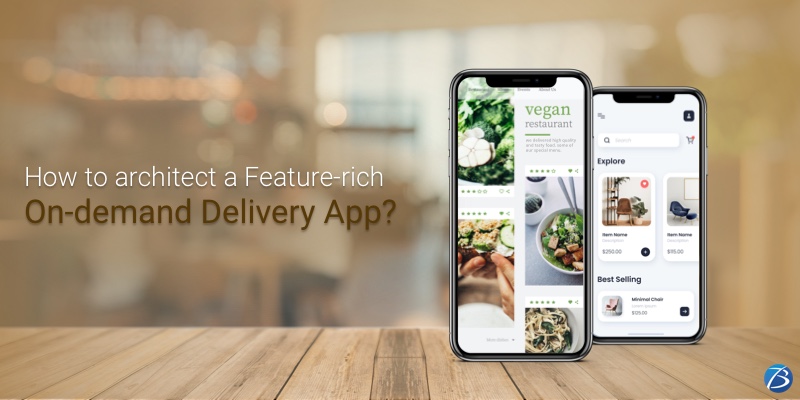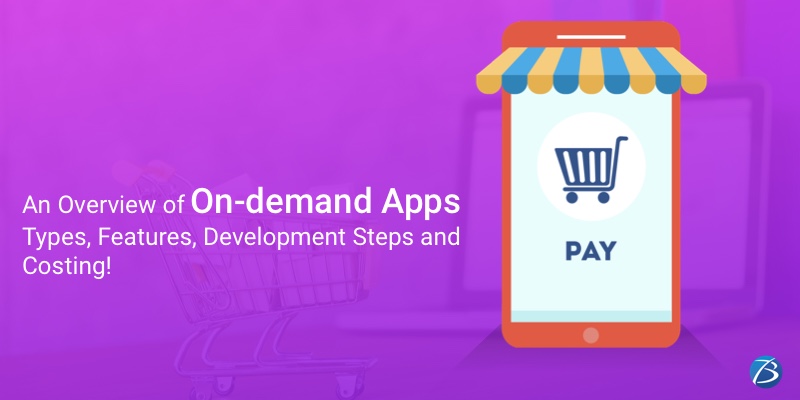An Overview: Architecting a Feature-rich On-demand Delivery App!


The on-demand market has emerged to be a fiercely competitive market in recent years. Almost all existing industrial domains, whether food, grocery, health, and medicines, education, entertainment industry, home service, transportation, or even freelancing jobs, have been captured by the on-demand economy in a very short period of time.
You would be amazed to know that the on-demand economy in the year 2016-17accounted for 14 billion USD for just the transportation sector in the US alone. This report by a renowned portal- Statista,aptly proves the potential of the on-demand sector.
Also, as stated by a PWC report, by the year 2025, the on-demand apps and websites market will cross the revenue of $335 billion.
These numbers depict how massive the future scope of this industry is. So, it is essential for budding entrepreneurs and start-up companies, and even the big players in the corporate world to have knowledge of this economy. And this article is a brief guide on this topic- on-demand app development. Here we will be covering details like on-demand app benefits, their types, features, working, etc. Please read ahead to know more.
Top-notch Benefits of the On-demand Apps
- Unlimited business opportunities in diverse domains
- Scalability and security
- Cashless payment facility
- Ease of ordering the products or services for customers
- Real-time tracking
- One-click cancellation of orders
- Enhancement of customer service
- Reports and analytics of users’ activities
- Measurable online presence
Step-wise Workflow of the On-demand Apps
All varieties of on-demand delivery applications have similar work principles. Here are the fundamental steps that explain the working of such apps.
- Registration– Firstly, the consumers, as well as the service providers, need to sign up using either their mobile number or social media accounts, or other available options.
- Inquiry or Order Placement– Next, a consumer searches for the required products or services and then, places his/her inquiry or order on the app.
- Acceptance/Denial of Request– Then the service provider accepts or denies the order. Usually, denial happens in rare cases when there occur some internal or technical issues. Once the order is accepted, the service provider can approve it for further processing.
- Payment– Payment delivery depends completely on the consumer’s wish. Some consumers may make online payments in advance and in some cases, they may opt for cash-on-delivery after the order is completed.
- Order Tracking– Next, the consumers, as well as the service providers, can track the order in real-time using the on-demand app. During this stage, the consumers can connect with the service providers if required. They may even cancel the order if they want.
- Final Delivery– Finally, when the product gets delivered to the consumers, the process is complete. After this, the consumers may drop reviews on the app, but this is optional.
Basic Types of On-Demand Service Apps
Consumer to Consumer (C2C): This kind of on-demand mobile app is an interface between the local service providers and end-users or consumers. Examples of these types of apps include Airbnb, Tinder, and even some ride-sharing apps.
Business to Consumer (B2C): This type of business model connects the consumersdirectly with the businesses. These apps are usually created by individual businesses, for instance, a restaurant creating a food delivery app for its consumers, or a pharmacy creating a drug-delivery app for itscustomers.
Business to Business (B2B): In this type of application, one business enterprise sells its products or services to other businesses or enterprises. Walmart is an apt example of this category. It has its own on-demand app for tracking and managing its products while dealing with other businesses.
Tech-stack used for creating Futuristic On-demand Applications
For creating an impactful app, it is vital to use an advanced tech stack. The on-demand app developersand the concerned team should be equipped with some of thecore technologies like the below:
Frameworks: Angular, React Native, React, jQuery, Bootstrap, Node.js, Ionic
Programming Languages: Java, Swift, Laravel, PHP, Kotlin, JavaScript, Flutter, HTML5, CSS3
Database: MySQL, MongoDB, PostgreSQL
Hosting Platform: AWS
Web Server:Apache HTTP Server
Utilities: Microsoft Azure, Cloudflare
Analytics: Google Analytics
Payment Gateway: Stripe, PayPal
Push Notifications and SMS Integration: Twilio
Must-have Features of the On-Demand Mobile Applications
For Consumer App
- User profile for the customers to register and sign in
- Searching products/services and booking orders
- Push notifications and alerts of their orders, latest offers, discounts, etc.
- GPS for live tracking of orders
- Secure and flexible payment models like credit cards, debit cards, wallets, cash, etc.
- Order history to check previous orders, refund data, etc.
- Reviews, ratings, and feedback
- Customer support
For Service Provider App
- Profile creation for the service providers to easily register and sign in
- Accepting and declining requests within a stipulated time
- Alert messages and push notifications
- Choosing online or offline status for showing their availability for any service
- Payment module for having a record of their earnings
- Chatting feature to communicate with customers
- Special panel for vendors or service providers for managing their riders, staff, services, end-users, billing, etc.
- Informative dashboard for viewing service histories, performance, earnings, losses, and related statistics
For Admin App
- Interactive admin dashboard
- Panel for customer management- customer information management, order cancellation,payment management, discounts, etc.
- Panel for management of service providers- managing the listing of earnings, penalties, coupon codes, discount offers, etc.
- Information of pricing and commissions
- Real-time service tracking
- Trackinganalytics and reports for business decision-making
Procedure to Fabricate a Full-fledged On-Demand Delivery App

Determining Business Goals and Target Audience
Before starting with the technical part of the app development process, it is necessary to decide on the purpose of the project, the end goals, and the details of your target audience. For this, research about your competitors, get data from online surveys, and get ideas from similar apps in the market.
Creating a Checklist for Executing the Development Plan
The next step is to prepare a checklist for your development team to ease out the execution of the project. This checklist should include the following:
- Products or services to add to the app, their availability, details of catalog,etc.
- Feature list as required
- Confirmation of order requirement from the customer point of view
- Details of integration
- Third-party suppliers
- Costs of products/services
- Deadline of project completion
Preparing a Business Checklist of Vital Project Considerations
What type of application software do you want to develop? A flower delivery app? A travel on-demand app? Or what else? Also, what features do you want to integrate into the app? Are there any other considerations? Ask these questions to yourself and create a checklist accordingly; the checklist may include:
- Customer support service
- Logistics and suppliers
- Merchant data
- Flexible hours
- Delivery charges
- Discounts and offers
- Any legal authorities and standards to abide by
- Security considerations
Hiring the Right App Development Partner
Now you are set to begin with the technical responsibilities. So, it is time to hire your technical partner i.e. the apt app development firm, if you do not have an in-house team. This partner musthave the proven experience, skills, and expertise to develop a modern-day on-demand application. So, perform thorough research and hire a dedicated team.
UI/UX Design and Technical Considerations
Discuss your concept with your designers and developers for them to create a wire-frame of the project. Also discuss with them all the technical aspects of the project like programming languages to be used, app platforms, etc. before beginning with the project development.
Creation of MVP or a Full-fledged App
It is always a better idea to develop an MVP i.e. a Minimum Viable Product because it helps to test your app idea in the market and gain early customers on low budgets. Creating an MVP is comparatively a low-risk idea. But, if you have the flexibility of time and money, you may opt for a full-fledged app as well.
App Development
Once you have decided on whether to develop an MVP app or a feature-rich on-demand app, it is time to begin with the development process. Make sure that your team follows agile development techniques for an organized approach and optimum output.
Testing and Launching the App
Test the app at every stage of development and also after the development process is completed. The quality analysts should get all the bugs and errors fixed to ensure successful project delivery and also make sure that the app offers the best possible user experience.Finally, launch the app on the respective platforms.
Concluding Words:
On-demand apps are flourishing more than ever and they are surely going to be the next big thing in the mobility world. Moreover, the pandemic situation due to the outbreak of coronavirus has given rise to numerous on-demand platformsin almost every business sector. So, undoubtedly, there is tremendous scope for new on-demand ideas and apps.
With this, I would like to wind up this article.
Do comment below to share your take on this topic.
Also, do share with us your experiences about the on-demand apps you developed or are willing to develop.


